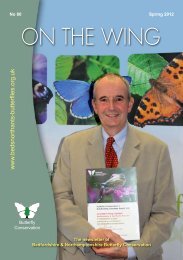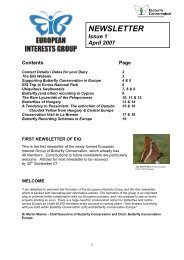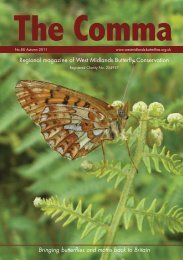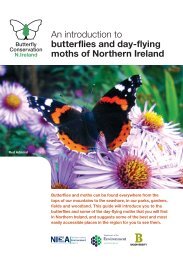Fritillary Butterflies of Dartmoor - Butterfly Conservation
Fritillary Butterflies of Dartmoor - Butterfly Conservation
Fritillary Butterflies of Dartmoor - Butterfly Conservation
You also want an ePaper? Increase the reach of your titles
YUMPU automatically turns print PDFs into web optimized ePapers that Google loves.
RHÔS PASTURE HABITAT<br />
DARTMOOR IN LATE SUMMER<br />
Scrub is important for species such as Reed<br />
Bunting and Dormouse; scrub species should<br />
cover a maximum <strong>of</strong> 5-10% <strong>of</strong> the total area<br />
WET GRASSLANDS<br />
The unimproved, wet valley<br />
bottoms and poorly draining,<br />
shallow slopes away from the<br />
open moor on <strong>Dartmoor</strong> are<br />
known as Rhôs pasture or Purple<br />
Moor-grass and Rush pasture.<br />
They are rich in wildlife with<br />
characteristic plants such as<br />
Meadow Thistle, Heath Spotted<br />
Orchid, Saw-wort and Devil’s-bit<br />
Scabious usually growing amongst<br />
vegetation dominated by Purple<br />
Moor-grass and Sharp-flowered<br />
Rush. The habitat typically occurs<br />
as part <strong>of</strong> a patchwork with wet<br />
heath, drier grassland, wet<br />
woodland and scrub habitats.<br />
Devil’s-bit Scabious<br />
An uneven tussocky structured sward (height range<br />
10-30cm-4-12”) with frequent flowering plants<br />
such as Devil’s-bit Scabious and Marsh Violet<br />
Rush patches can be a natural component <strong>of</strong> the<br />
habitat, but if they start to dominate they can be<br />
controlled through cutting, preferably in September<br />
to avoid disturbance to ground-nesting birds<br />
Light grazing in the period May- September with hardy<br />
breeds such as South Devon cattle or <strong>Dartmoor</strong> ponies<br />
On <strong>Dartmoor</strong> the Marsh <strong>Fritillary</strong><br />
can be found on this type <strong>of</strong> wet<br />
grassland. The butterfly flies during<br />
May and June and lays its eggs on<br />
the underside <strong>of</strong> large leaves <strong>of</strong> the<br />
host plant, Devil’s-bit Scabious.<br />
Another characteristic butterfly is<br />
the Small Pearl-bordered <strong>Fritillary</strong>.<br />
Adults fly from May until the end <strong>of</strong><br />
July and the female lays her eggs<br />
singly on or near the host plant Marsh<br />
Violet. This butterfly can also be found<br />
in Bracken habitat, where other<br />
species <strong>of</strong> violet are used as host plant.<br />
A typical moth species associated with<br />
Rhôs pastures is the Narrow-bordered<br />
Bee Hawk-moth. This beautiful day<br />
flying moth, that resembles a large<br />
bumblebee, has undergone a<br />
substantial decline. <strong>Dartmoor</strong> Rhôs<br />
pastures are one <strong>of</strong> the remaining<br />
strongholds for this species.<br />
Narrow-bordered Bee Hawk-moth<br />
Unmanaged Rhôs pastures suffer<br />
from encroachment <strong>of</strong> coarse grasses<br />
and scrub, leaving the habitat unsuitable.<br />
However, these areas can be restored<br />
through burning, grazing and cutting<br />
Other typical species include<br />
Dormouse, Snipe, Reed Bunting<br />
and Grasshopper Warbler. The<br />
habitat is also used by Barn Owls<br />
and Short-eared Owls for hunting.<br />
Many species associated with<br />
Rhôs pasture have declined rapidly.<br />
The primary cause has been loss <strong>of</strong> their<br />
habitat; damp grasslands have been<br />
drained, fertilised and stocked more<br />
heavily. More recently, populations are<br />
being lost because these agriculturally<br />
marginal areas are no longer grazed.<br />
This results in encroachment <strong>of</strong> coarse<br />
grasses and scrub, leaving the habitat<br />
unsuitable for the butterflies and many<br />
<strong>of</strong> the other associated species.<br />
IDEAL RHÔS PASTURE HABITAT<br />
IN LATE SUMMER<br />
WHAT YOU CAN DO TO HELP<br />
To manage your Rhôs pasture<br />
to benefit a wide range <strong>of</strong><br />
characteristic species, including<br />
the Marsh <strong>Fritillary</strong> and Small<br />
Pearl-bordered <strong>Fritillary</strong>, aim for:<br />
■ An uneven, tussocky, structured<br />
sward at the end <strong>of</strong> the grazing<br />
season (normally end <strong>of</strong> September)<br />
between 10-30 cm high (4-12”).<br />
■ Frequent flowering plants present<br />
such as Devil’s-Bit Scabious, Marsh<br />
Violet and Heath Spotted Orchid. Also<br />
dwarf shrubs like Cross-leaved Heath.<br />
■ Scrub species covering a maximum<br />
<strong>of</strong> 5-10% <strong>of</strong> the total area.<br />
This is best achieved by:<br />
■ Light grazing in the period May-<br />
September with cattle (eg. Galloway,<br />
South Devon) and/or hardy ponies<br />
(eg. <strong>Dartmoor</strong>).<br />
■ Check the site regularly; a rough<br />
guideline is 1 cow or pony per<br />
hectare (2.5 acres) for 3 months,<br />
but stocking rates may need to<br />
vary according to site conditions;<br />
it may be necessary to move the<br />
stock <strong>of</strong>f early in a dry year, or<br />
to stock later in a wet year<br />
(September-November) to<br />
achieve suitable habitat conditions.<br />
Ideal uneven structured sward with<br />
tussocks and with abundant host plants<br />
Devil’s-bit Scabious and Marsh Violet<br />
Marsh <strong>Fritillary</strong> caterpillar web<br />
on Devil’s-bit Scabious<br />
■ Occasional cutting or burning in<br />
late winter (January-early March)<br />
might be useful in areas <strong>of</strong> the site<br />
that are ignored by the livestock<br />
and if a litter layer has built up;<br />
avoid burning or cutting more<br />
than 1/3 <strong>of</strong> the site in any year.<br />
Please avoid:<br />
■ Extensive poaching or over-grazing<br />
where the sward is grazed tightly;<br />
this leaves the habitat unsuitable<br />
for species that are dependent on the<br />
shelter provided by a tussocky sward.<br />
■ Under-grazing that leads to<br />
encroachment <strong>of</strong> coarse grasses;<br />
a dead litter layer will build up<br />
smothering the flowering plants<br />
and scrubby species will rapidly<br />
invade the site.<br />
Because <strong>of</strong> natural variation in site<br />
conditions and grazing preferences<br />
<strong>of</strong> stock it might not be feasible<br />
to achieve ideal habitat conditions<br />
across the whole site all <strong>of</strong> the time.<br />
However, aim to maximise the amount<br />
<strong>of</strong> ideal habitat by adjusting stocking<br />
levels and the grazing period to<br />
the site conditions during that year.<br />
If necessary, encourage grazing<br />
<strong>of</strong> under-grazed areas by burning<br />
or cutting.<br />
Aim for a range in height between 10-30cm<br />
(4-12”) high at the end <strong>of</strong> the summer<br />
Devil’s-bit Scabious is an important nectar<br />
source for many insects in late summer<br />
Marsh Violet, the host plant <strong>of</strong> the Small<br />
Pearl-bordered <strong>Fritillary</strong> in wet grassland<br />
Marsh <strong>Fritillary</strong> caterpillar web on<br />
the host plant Devil’s-bit Scabious.<br />
Meadow Thistle in Rhôs pasture<br />
FRITILLARIES<br />
AS INDICATORS OF A<br />
HEALTHY ENVIRONMENT<br />
<strong>Butterflies</strong> are very sensitive<br />
and react rapidly to changes<br />
in their environment.<br />
Healthy populations <strong>of</strong> specialist<br />
butterflies, like the Fritillaries on<br />
<strong>Dartmoor</strong>, are associated with the<br />
occurrence <strong>of</strong> other specialist species,<br />
areas <strong>of</strong> high biodiversity and habitat<br />
quality. Habitat management for the<br />
<strong>Fritillary</strong> butterflies therefore benefits<br />
a wide range <strong>of</strong> other species<br />
associated with Rhôs pastures<br />
and Bracken habitats, and thriving<br />
populations <strong>of</strong> the Fritillaries indicate<br />
a healthy natural environment.<br />
RESTORATION OF SITES<br />
Many sites where Fritillaries<br />
used to occur have declined<br />
due to lack <strong>of</strong> management.<br />
Coarse grasses in Rhôs pastures<br />
and dense Bracken in Bracken habitats<br />
tend to dominate and out compete the<br />
host plants that are so important for the<br />
butterflies. Scrub encroachment, left<br />
to continue, will result in the loss <strong>of</strong><br />
grassland to scrub and woodland.<br />
If you are planning to restore<br />
management to a site, contact<br />
one <strong>of</strong> the organisations listed under<br />
further help and advice. In general,<br />
re-introduce grazing management<br />
gradually and when cutting or burning<br />
areas, avoid tackling more than 1/3<br />
<strong>of</strong> the habitat in any one year. This<br />
is especially important if populations<br />
<strong>of</strong> important species like the<br />
Fritillaries are still present.<br />
Green Hairstreak<br />
SCRUB WORKS<br />
Regular scrub management<br />
is <strong>of</strong>ten necessary in <strong>Fritillary</strong><br />
habitats. However, scrub is<br />
important for many species,<br />
such as Green Hairstreak,<br />
Yellowhammer, Dormouse,<br />
Reed Bunting and other insects.<br />
Scrub should therefore never be<br />
eradicated; levels <strong>of</strong> 5-10% across<br />
the site are desirable. When carrying<br />
out scrub control, avoid damage to<br />
the habitat by heavy machinery.<br />
Always remove cut materials from<br />
the site, or burn cut materials in<br />
a few designated areas, preferably<br />
on galvanised iron sheets so that<br />
the nutrient-rich ash can be easily<br />
removed from the site. Treat stumps<br />
with an appropriate herbicide<br />
to prevent re-growth immediately<br />
after cutting.<br />
<strong>Butterfly</strong> <strong>Conservation</strong> is a registered charity and a non-pr<strong>of</strong>it making company, limited by guarantee. Registered in England No. 2206468 - Registered Charity No. 254937.<br />
Photographs by: Jim Asher, Norman Baldock, Alan Barnes, Anja Borsje, Caroline Bulman, Peter Burgess, Sam Ellis, Martin Warren and Robert Wolton.<br />
Illustrations by Mike Langman. Written by Anja Borsje and Caroline Bulman. Designed and produced by cellcreative 01942 681648.<br />
FURTHER HELP<br />
AND ADVICE<br />
For further information and<br />
advice, please contact <strong>Butterfly</strong><br />
<strong>Conservation</strong> below.<br />
Financial support may be available<br />
through Environmental Stewardship<br />
to enable sympathetic management<br />
<strong>of</strong> environmental features on your<br />
holding. This grant scheme is<br />
administered by Natural England.<br />
Visit www.naturalengland.org.uk<br />
or contact your local <strong>of</strong>fice for<br />
more information.<br />
<strong>Dartmoor</strong> National Park Authority<br />
also has management agreements<br />
on some <strong>Fritillary</strong> areas and can<br />
provide advice on management.<br />
contact 01626 832093<br />
This leaflet has been part-funded by Natural England and has been produced as part <strong>of</strong> the Two Moors Threatened <strong>Butterfly</strong> Project funded by:<br />
<strong>Butterfly</strong> <strong>Conservation</strong>, <strong>Dartmoor</strong> National Park Authority, Environment Agency, Exmoor National Park Authority, Natural England,<br />
<strong>Dartmoor</strong> Sustainable Development Fund, Exmoor Sustainable Development Fund, Esmée Fairbairn Foundation and the Exmoor Trust.<br />
HEAD OFFICE<br />
Manor Yard, East Lulworth,<br />
Wareham, Dorset BH20 5QP<br />
t 0870 774 4309<br />
e info@butterfly-conservation.org<br />
www.butterfly-conservation.org<br />
upper Emsworthy Mire<br />
lower Pearl-bordered <strong>Fritillary</strong><br />
<strong>Fritillary</strong> <strong>Butterflies</strong><br />
<strong>of</strong> <strong>Dartmoor</strong><br />
A practical guide to<br />
managing Bracken and<br />
Rhôs pasture habitats<br />
for Fritillaries on <strong>Dartmoor</strong>
THE DARTMOOR LANDSCAPE<br />
The beautiful <strong>Dartmoor</strong> landscape<br />
that we see today is the product<br />
<strong>of</strong> centuries <strong>of</strong> traditional land-use,<br />
creating a landscape rich in wildlife.<br />
The future <strong>of</strong> the characteristic<br />
<strong>Dartmoor</strong> wildlife is strongly<br />
linked to the continuation <strong>of</strong><br />
traditional farming practices.<br />
Recently, changes in the economics <strong>of</strong> agriculture have<br />
led to the cessation <strong>of</strong> management within land that is<br />
marginal to the farm business. It is exactly these areas<br />
like Bracken slopes and Rhôs pastures that are vital<br />
for the <strong>Fritillary</strong> butterflies <strong>of</strong> <strong>Dartmoor</strong>, as they have<br />
escaped previous major agricultural improvements.<br />
Cessation <strong>of</strong> management quickly leads to these<br />
areas becoming unsuitable for the Fritillaries and<br />
many other species <strong>of</strong> animals and plants. As a result,<br />
many species are declining dramatically and urgent<br />
action is needed to save them.<br />
PRIORITY AREAS FOR FRITILLARIES ON DARTMOOR<br />
This leaflet describes<br />
the habitats in which these<br />
threatened butterfly species<br />
occur and explains how<br />
your land can be managed<br />
to safeguard these species.<br />
There are five species <strong>of</strong> <strong>Fritillary</strong><br />
butterfly for which <strong>Dartmoor</strong> is<br />
important and they can be found<br />
in two different types <strong>of</strong> habitat:<br />
■ Bracken stands containing<br />
abundant violets.<br />
■ Rhôs pastures (the local<br />
name for Purple Moor-grass<br />
and Rush pastures).<br />
One <strong>of</strong> the most important areas<br />
<strong>of</strong> Bracken habitat for the Fritillaries<br />
is the Dart valley, where cattle and<br />
ponies graze extensive areas <strong>of</strong> acid<br />
grassland and Bracken in late winter<br />
and summer to benefit the High Brown,<br />
Pearl-bordered, Small Pearl-bordered<br />
and Dark Green <strong>Fritillary</strong>.<br />
One <strong>of</strong> the typical Rhôs pasture areas<br />
where the Marsh <strong>Fritillary</strong> and the Small<br />
Pearl-bordered <strong>Fritillary</strong> are found is<br />
the sheltered, wet valley system in the<br />
enclosed farmland between King Tor<br />
and Easdon Tor, west <strong>of</strong> the village<br />
<strong>of</strong> North Bovey. Here, landowners are<br />
grazing their Rhôs pastures in summer<br />
with cattle and ponies to create ideal<br />
habitat conditions for these butterflies<br />
and other species such as Narrowbordered<br />
Bee Hawk-moth, Snipe<br />
and Reed Bunting.<br />
Bracken habitat at Aish Tor<br />
Rhôs pasture habitat near Easdon Tor<br />
HIGH BROWN FRITILLARY<br />
This butterfly is one <strong>of</strong> the<br />
most rapidly declining species<br />
in the UK and there is huge<br />
potential for conserving this<br />
species on <strong>Dartmoor</strong>.<br />
The butterfly flies from mid June<br />
to August with eggs being laid singly<br />
on dead leaves or Bracken stems.<br />
The species over-winters as an egg,<br />
hatching in early spring. The caterpillar<br />
can be found basking on Bracken litter<br />
in the spring, but they are well<br />
camouflaged, resembling dead<br />
Bracken fronds. They pupate<br />
under dead Bracken or leaves.<br />
DARK GREEN FRITILLARY<br />
Adults fly from June to August,<br />
and eggs are laid singly on dead<br />
plant material, or on violets.<br />
Eggs hatch in summer, but the<br />
caterpillar immediately hibernates.<br />
They begin feeding in spring on<br />
violets, and bask on the vegetation.<br />
They pupate in a tent <strong>of</strong> grass<br />
stems held loosely together with<br />
silk. This is one <strong>of</strong> the most common<br />
Fritillaries across <strong>Dartmoor</strong> and the<br />
one most likely to be encountered<br />
in Bracken habitats.<br />
PEARL-BORDERED<br />
FRITILLARY<br />
This is the earliest <strong>Fritillary</strong> to be<br />
seen flying and can be found from<br />
April until the end <strong>of</strong> May, although<br />
occasionally second broods occur,<br />
with adults flying in August.<br />
Eggs are laid singly on dead Bracken<br />
near violets. The caterpillars hibernate<br />
and re-emerge in spring, basking in<br />
the warmest and driest habitats, and<br />
feeding on the leaves and flowers <strong>of</strong><br />
violets. <strong>Dartmoor</strong> is an important area<br />
for this butterfly and it is found more<br />
widely in Bracken habitats compared<br />
to the High Brown, but despite this,<br />
is still suffering massive declines.<br />
SMALL PEARL-<br />
BORDERED FRITILLARY<br />
This species flies in June and July, and<br />
can be found in both Bracken habitats<br />
and Rhôs pastures. Eggs are laid<br />
singly near violets on dead vegetation.<br />
The caterpillars feed until September,<br />
when they hibernate. These caterpillars<br />
do not bask in the spring, but spend their<br />
time hidden in the vegetation, only coming<br />
out to feed on violets. This species is<br />
declining nationally but still found widely<br />
on <strong>Dartmoor</strong>. In warm summers a<br />
second brood may occur in August.<br />
MARSH FRITILLARY<br />
The Marsh <strong>Fritillary</strong> flies from<br />
mid-May until the end <strong>of</strong> June.<br />
Eggs are laid in large batches on<br />
the host plant Devil’s-bit Scabious.<br />
The caterpillars spin a protective<br />
web over their host plant. The<br />
webs are conspicuous by the end<br />
<strong>of</strong> August, and the caterpillars can<br />
be found basking on the surface.<br />
The caterpillars hibernate and can be<br />
seen again in early spring, when they<br />
bask on dead leaf litter. This species is<br />
declining across Europe and <strong>Dartmoor</strong><br />
is one <strong>of</strong> the few strongholds for the<br />
butterfly in Britain.<br />
SILVER WASHED<br />
FRITILLARY<br />
The Silver-washed <strong>Fritillary</strong> also<br />
occurs on <strong>Dartmoor</strong>, but as it is<br />
predominantly a woodland species,<br />
it is beyond the scope <strong>of</strong> this leaflet.<br />
J F M A M J J A S O N D<br />
FLIGHT PERIOD<br />
OF EACH SPECIES<br />
BRACKEN HABITAT<br />
DARTMOOR IN SPRING<br />
Encroaching scrub and dense Bracken; areas<br />
like this can be restored to suitable habitat<br />
BRACKEN HABITATS<br />
Bracken is very common on<br />
<strong>Dartmoor</strong> covering about 5000<br />
hectares. Most <strong>of</strong> it is found in<br />
exposed areas that are unsuitable<br />
for <strong>Fritillary</strong> butterflies. However,<br />
sunny, sheltered slopes (below<br />
300m) where there is a patchwork<br />
<strong>of</strong> grass, Bracken and scrub,<br />
on south-facing hillsides, <strong>of</strong>ten<br />
provide ideal conditions.<br />
Here, the ground flora contains an<br />
abundance <strong>of</strong> violets, with a mixture<br />
<strong>of</strong> woodland plants such as Wood<br />
Sage, Bugle, and acid grassland<br />
plants such as Tormentil.<br />
Bracken is very important for<br />
the Fritillaries; during the summer<br />
it acts like a woodland canopy, helping<br />
to suppress grass growth and favour<br />
violets. The dead Bracken litter and<br />
standing trash provides a warm<br />
microclimate for the caterpillars when<br />
they are feeding on their hostplant<br />
the violet in early spring. Bracken litter<br />
refers to the broken down fragments<br />
in contact with the soil surface. Standing<br />
trash refers to the dead, un-degraded<br />
remains <strong>of</strong> fronds and stalks still<br />
standing or lying on the ground.<br />
Paths encourage animal movement across the site<br />
Extensive grazing by hardy cattle and ponies<br />
Mosaic <strong>of</strong> Bracken & grass with abundant violets<br />
Within Bracken habitats, each <strong>Fritillary</strong><br />
species occupies a distinct patch that<br />
reflects the temperature requirements<br />
<strong>of</strong> the caterpillar.<br />
The High Brown <strong>Fritillary</strong> uses the<br />
warmest areas <strong>of</strong> the site. It is usually<br />
restricted to south-facing slopes and<br />
requires the violets to grow through<br />
a thin layer <strong>of</strong> Bracken litter. <strong>Dartmoor</strong><br />
is one <strong>of</strong> the few areas in the country<br />
where this species survives.<br />
The Pearl-bordered <strong>Fritillary</strong> is usually<br />
restricted to sites with similar conditions,<br />
but can also be found in smaller, more<br />
fragmented sites and woodland fringes.<br />
Two other <strong>Fritillary</strong> butterflies can<br />
be found in Bracken habitats; the<br />
Small Pearl-bordered <strong>Fritillary</strong><br />
and the Dark Green <strong>Fritillary</strong>. Both<br />
species can breed in cooler vegetation<br />
and select violets growing in fairly tall,<br />
grassy vegetation with scattered<br />
Bracken. The Dark Green <strong>Fritillary</strong> is<br />
one <strong>of</strong> the most widespread Fritillaries<br />
and flies from mid-June to Mid-August.<br />
The Small Pearl-bordered <strong>Fritillary</strong><br />
is also found in wet grassland<br />
habitat where it uses Marsh Violet<br />
as its host plant.<br />
Areas with Bluebells indicate deeper soils & damp<br />
conditions - unsuitable for the <strong>Fritillary</strong> butterflies<br />
Broadleaved woodland encroachment<br />
up the valley sides can quickly result<br />
in loss <strong>of</strong> habitat<br />
Some scattered scrub is important for species such<br />
as Green Hairstreak, Stonechat and Yellowhammer<br />
Many <strong>Fritillary</strong> colonies in Bracken<br />
habitat are under threat as a result<br />
<strong>of</strong> the decline or abandonment<br />
<strong>of</strong> grazing, unsympathetic Bracken<br />
control and occasionally over-grazing.<br />
Abandonment and under-grazing<br />
quickly leads to total domination<br />
by Bracken or scrub encroachment<br />
resulting in the loss <strong>of</strong> plant species<br />
on which Fritillaries and other<br />
insects depend.<br />
Over-grazing can lead to an increase<br />
in grass cover, which is particularly<br />
detrimental to the High Brown and<br />
Pearl-bordered Fritillaries. Sympathetic<br />
management <strong>of</strong> Bracken, acid grassland<br />
and scrub mosaics will benefit a wide<br />
range <strong>of</strong> other species, including<br />
Whinchat and Lesser <strong>Butterfly</strong> Orchid.<br />
IDEAL BRACKEN HABITAT<br />
IN SPRING<br />
WHAT YOU CAN DO TO HELP<br />
To manage your Bracken habitat<br />
to benefit a wide range <strong>of</strong> species<br />
including the Fritillaries, aim for:<br />
■ A mosaic <strong>of</strong> Bracken interspersed<br />
with grassy patches and gaps<br />
in the canopy.<br />
■ Abundant violets growing through<br />
shallow Bracken litter and standing<br />
trash where there is little or no<br />
cover <strong>of</strong> grass.<br />
This is best achieved by:<br />
■ Extensive grazing <strong>of</strong> these acidic<br />
grassland and Bracken habitats<br />
by hardy cattle and ponies.<br />
The trampling action <strong>of</strong> the animals<br />
through Bracken stands, in particular<br />
during winter and early spring<br />
(usually February to April), is most<br />
important to help break up the<br />
dense standing trash. This also<br />
creates a network <strong>of</strong> paths running<br />
through the Bracken, which provides<br />
germination sites for violets. Light<br />
pony or cattle grazing in summer<br />
helps to open up the Bracken canopy<br />
and maintain grazing for stock.<br />
■ Cut scrub regularly where it is<br />
encroaching, but never eradicate<br />
it completely from the site.<br />
Animal movement has resulted in tracks<br />
and broken up Bracken litter, creating<br />
germination sites for violets<br />
Patches <strong>of</strong> grass encourages animal movement<br />
Ideal egg laying sites for Pearl-bordered and<br />
High Brown <strong>Fritillary</strong> are found where violets<br />
grow through a thin layer <strong>of</strong> Bracken litter<br />
■ Small amounts <strong>of</strong> mineral<br />
supplements & hay can be used<br />
to encourage stock to move through<br />
areas <strong>of</strong> dense Bracken, in particular<br />
in late winter, but please rotate feed<br />
areas to avoid poaching and move<br />
mineral licks regularly. Paths (approx<br />
tractor width) can also be cut through<br />
dense Bracken to encourage<br />
livestock movements.<br />
■ If Bracken becomes too dense<br />
and is out-competing other species,<br />
it can be controlled by cutting or<br />
bruising (only patches or strips)<br />
during the summer. Where cutting<br />
or bruising is not safe or appropriate,<br />
spraying can be an option. However,<br />
the impact should be carefully<br />
assessed before works should<br />
commence. When managing<br />
Bracken, avoid treating more than<br />
1/5th <strong>of</strong> the site in any year.<br />
■ Areas with a thick Bracken litter<br />
layer with sparse or no violets can<br />
also be burnt or cut in late winter.<br />
However, burning stimulates Bracken<br />
growth, so always follow up with<br />
further Bracken management, and/or<br />
appropriate grazing levels to produce<br />
the right conditions.<br />
High Brown <strong>Fritillary</strong> caterpillar<br />
in May with characteristic feeding<br />
damage showing on the violet leaf.<br />
Please avoid:<br />
■ Excessive poaching <strong>of</strong> the habitat<br />
as this <strong>of</strong>ten leads to grassy swards<br />
unsuitable for the Fritillaries.<br />
Because <strong>of</strong> natural variation in site<br />
conditions and grazing preferences<br />
<strong>of</strong> stock, it might not be feasible<br />
to achieve ideal habitat conditions<br />
across the whole site all <strong>of</strong> the time.<br />
However, aim to maximise the amount<br />
<strong>of</strong> ideal habitat by adjusting stocking<br />
levels if necessary, managing dense<br />
Bracken stands and by implementing<br />
measures to encourage livestock<br />
to move throughout the site.







